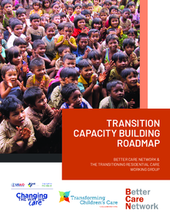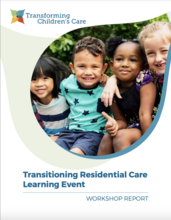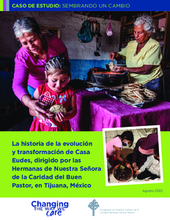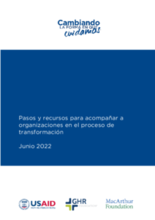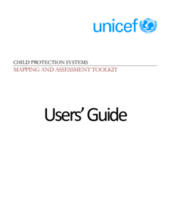Connecting the transition to the system and national care reforms
In the previous phase, organizations explored transition in light of their national context as a part of their deliberation. In this phase, a deeper analysis of the national and local child protection and care system should be undertaken to inform the transition strategy and decisions around post transition programming.
The aim of this step is to ensure the transition of the individual residential care service is connected to systems reform efforts and outworked in accordance with relevant laws, policies, procedures, processes, guidelines, or operating standards. This helps organizations draw on available resources to support transition, including services to aid with reintegration, and it can also create opportunities for organizations to help strengthen government systems. It also helps ensure decisions made about post transition programming are informed by knowledge of the gaps and needs in the child protection and care system. It ensures transitions occur as part of child protection and care reforms rather than parallel to it.
This step is concerned with surveying the national/local child protection and care system and identifying the relevant components that need to be integrated into the organization’s transition procedures and strategy.
Key aspects of the system to survey and assess for relevance to transition include:
- Child protection laws, regulations and policies: What do these require the transitioning organisation to do or comply with throughout the transition?
- Action plans, sector plans, implementation plans and national budgets: What exists that relates to scaling back the use of residential care, the number of children in care or transitioning service systems? How do these influence the approach to transition or indicate support that might be on offer?
- Standard operating procedures, guidelines: What aspects of transition, reintegration, family-based care are covered by existing guidance or SoPs that outline the approach that needs to be taken and what does the transitioning organisation need to do to conform with these?
- Gatekeeping mechanisms: What gatekeeping mechanisms are in place and how does this influence reintegration practice?
- Case Management Systems: What case management systems are already in place and used by government and/or service providers? How can the organisation access, utilize or integrate their systems into these in the transition process?
- Social protection services: What exists, what is the eligibility criteria and how can the organisation support families to access these services where relevant?
- Child and family welfare services: What child and family services already exist? How can the organisation assist children and their families to access services that will support their reintegration and strengthen the family?
- Alternative Care Services: What family-based alternative care services already exist and how can children requiring family-based care be referred to these services if alternative care is deemed necessary?
- Community-level child protection services: What are the local level child protection services? How can the organisation connect with these services and/or collaborate for monitoring and/or child and family service provision purposes post reunification?
- Care Leaver Support: What support for Care Leavers is mandated under law? Who is responsible for providing it? How can the organisation comply or access this support for children or young people reintegrating or exiting care? What non-government aftercare services exist and how can they be accessed?
- Technical support services: Are there agencies or organizations providing in-country technical support to transitioning organizations? What type of support is available and how can it be accessed if needed?
- Cultural practices: What are the cultural practices (those that aid and those that are barriers to aspects of transition) and cultural sensitivities that need to be understood? How will these influence the approach to transition and what is needed to overcome barriers?
- Social work standards and social workforce training opportunities: Are there social work standards in place? Is there a social workforce strengthening plan that includes training that practitioners involved in transition could access?
Key topics: gather information that helps to inform post transition programming decisions:
- Key causes of family separation: What has been evidenced as the key drivers and vulnerabilities that lead to family separation and admission into residential care?
- Gaps in the child and family welfare services: What gaps are there in terms of prevention and early intervention services that could address the key causes of separation? Are these gaps geographical, due to limited capacity or system wide?
- Gaps in the child protection service system: What gaps are there in terms of remedial child protection services and family-based alternative care? Are these gaps geographical, due to limited capacity or system wide?
- Priorities for service development: What types of services are being prioritised for development by government or flagged as key to child protection and care reform efforts? Are there opportunities to partner with government in developing new services?
Key milestones associated with this step are, the organization’s key leaders and technical support providers have:
- Identified and understand all relevant child protection and alternative care laws and policies that have a bearing on how transition and reintegration must be outworked have been identified.
- Sufficient knowledge of the local system and context to develop contextually relevant transition and reintegration strategy that conforms with the country’s policy framework.
- Sufficient understanding of issues affecting children and families and causing separation and the gaps in the current child welfare and child protection and care system to consider post transition programming from a systems perspective.
Resources
Displaying 1 - 7 of 7
This document outlines a capacity-building roadmap for scaling up the transition of residential care services. It is an interagency resource developed by Better Care Network and the Transitioning Residential Care Working Group (Transforming Children's Care Collaborative).
This report captures the key insights, trends, learnings, and participant inputs from the Transitioning Residential Care Services Learning Event held in October 2022 which was organized and hosted by the Transitioning Residential Care Working Group as part of the Transforming Children’s Care Global Collaborative Platform.
Este estudio de caso destaca la transición de servicios de cuidado residencial a los basados en la familia y comunidad, realizado por las Hermanas de Nuestra Señora de la Caridad del Buen Pastor, en Tijuana B.C., México.
This case study highlights the transition of the Sisters of Our Lady of Charity of the Good Shepherd in Tijuana. It presents the highs and lows that come with a change process of moving from residential care to community-based services focused on family strengthening.
Este documento está diseñado para orientar a las personas u organizaciones que están apoyando un proceso de transición para pasar de proporcionar atención residencial a un modelo que promueva la atención familiar y comunitaria. El documento está diseñado en torno a las Fases de la Transición de Better Care Network. Se basa en el trabajo que Changing the Way We Care ha realizado en los últimos años para apoyar a diferentes proveedores de atención residencial, tanto religiosos como laicos, en su propio proceso de transición. Hay ejemplos y enlaces a herramientas relevantes, mensajes y actividades sugeridas que pueden utilizarse para apoyar las diferentes fases del proceso.
Assists in the development and application of an analytic tool for mapping and assessing existing child protection policies, laws and services for adequacy and to identify obstacles and opportunities in implementation, especially in reaching vulnerable or excluded groups.

